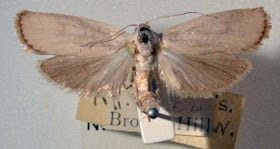Xylomimetes Turner, 1916
Xylomimetes Turner, 1916. A third contribution to a knowledge of the Lepidopterous fauna of Ebor Scrub, N.S.W. Proceedings of the Linnean Society of New South Wales, 41: 249–260 [13 Sept.1916] [256]. Type species: Pilostibes trachyptera Turner, 1900 by original designation.
Xylomimetes Turner, 1916 [Cryptophasidae]. Fletcher, T. B., 1929, A list of generic names used for Microlepidoptera. Memoirs of the Department of Agriculture of India, 11: 1-244 [237].
Xylomimetes Turner, 1916. Common, in Nielsen, Edwards, & Rangsi, 1996, Checklist of the Lepidoptera of Australia. Monographs on Australian Lepidoptera, 4: i-xiv, 1-529 & CD-ROM [88].
Xylomimetes Turner, 1916. Beccaloni, G. W., Scoble, M. J., Robinson, G. S. & Pitkin, B. (Editors). 2003. The Global Lepidoptera Names Index (LepIndex). World Wide Web electronic publication. http://www.nhm.ac.uk/entomology/lepindex [accessed 1 May 2010].
Xylomimetes Turner, 1916. Edwards, E. D. (2003), Xyloryctinae. Australian Faunal Directory. Australian Biological Resources Study, Canberra. http://www.environment.gov.au/biodiversity/abrs/online-resources/fauna/afd/taxa/XYLORYCTINAE [accessed 17 June 2010].
Original description, Turner 1916
Gen. Xylomimetes nov.
ξμλομιμητος, an imitator of wood.
Palpi moderately long, ascending, recurved; second joint long, reaching base of antennae, thickened with closely appressed scales, rather strongly expanded at apex; terminal joint about ½ second, more slender, smooth, acute. Antennae of ♂ slightly serrate, shortly ciliated. Thorax not crested. Anterior tibiae expanded with dense hair-scales. Forewings with tufts of raised scales in disc on upper surface; 2 from ¾, 7 absent, 8 and 9 short-stalked, or closely approximated at base and for some distance. Hindwings with 3 and 4 connate, 5 weakly developed, 6 and 7 connate.
Type Pilostibes trachyptera Turn., (Trans. Roy. Soc. S. Aust., 1900, p. 6). A very distinct genus, most nearly allied to Pilostibes Meyr.
Description:
Head:
Thorax:
Abdomen:
Immature stages:
Distribution: New South Wales, Queensland. Endemic. (Edwards, 2003).
Remarks:
_____________________________________
Xylomimetes scholastis Turner, 1916
ANIC
Rous, NSW. Photo Len Willan.
Springbrook, NSW. Photo Len Willan.
Xylomimetes scholastis Turner, 1916. A third contribution to a knowledge of the Lepidopterous fauna of Ebor Scrub, N.S.W. Proceedings of the Linnean Society of New South Wales, 41: 249–260 [13 Sept.1916] [256]. Holotype ANIC ♂, Ebor Scrub, NSW.
Xylomimetes scholastis Turner, 1916. Common, in Nielsen, Edwards, & Rangsi, 1996, Checklist of the Lepidoptera of Australia. Monographs on Australian Lepidoptera, 4: i-xiv, 1-529 & CD-ROM [88].
Xylomimetes scholastis Turner, 1916. Beccaloni, G. W., Scoble, M. J., Robinson, G. S. & Pitkin, B. (Editors). 2003. The Global Lepidoptera Names Index (LepIndex). World Wide Web electronic publication. http://www.nhm.ac.uk/entomology/lepindex [accessed 1 May 2010].
Xylomimetes scholastis Turner, 1916. Edwards, E. D. (2003), Xyloryctinae. Australian Faunal Directory. Australian Biological Resources Study, Canberra. http://www.environment.gov.au/biodiversity/abrs/online-resources/fauna/afd/taxa/XYLORYCTINAE [accessed 17 June 2010].
Original description, Turner 1916
Xylomimetes scholastis, n. sp.
ςχολαστις, sluggish.
♂. 40 mm. Head white, base of sidetufts and face brownish. Palpi brownish, terminal joint and apex of second joint white. Antennae brown-whitish; ciliations in ♂ ½. Thorax whitish, posteriorly brownish-tinged. Abdomen whitish; second segment and bases of succeeding segments on dorsum ferruginous irrorated with whitish. Legs brown- whitish; posterior pair whitish. Forewings oblong, somewhat dilated posteriorly, costa moderately arched near base and apex, in middle nearly straight, apex rounded, termen slightly oblique, rounded beneath; four, strong tufts of raised scales, one at base of dorsum, one on fold about middle, and one at each posterior angle of cell; pale whitish-brown; a broad, suffused, white, costal streak, narrow at base, and not reaching apex; a fine, blackish, longitudinal streak from ¼ to middle along upper edge of cell; two or three, fine, short, similar streaks on veins beyond middle; cilia pale brownish barred with whitish. Hind wings considerably broader than forewings; ochreous-whitish; cilia ochreous-whitish.
Closely allied to X. trachyptera, which is also a scrub-species.
One example, beaten from undergrowth. It fell to the ground and remained motionless, exactly resembling a fragment of dead wood.
Diagnosis:
Description:
Head:
Thorax:
Abdomen:
Food plants:
Flight period:
Distribution: New South Wales, Queensland. Endemic. (Edwards, 2003).
Remarks:
Xylomimetes trachyptera (Turner, 1900)
ANIC
Eumundi, QLD. Photo Len Willan.
Pilostibes trachyptera Turner, 1900, New Micro-lepidoptera - mostly from Queensland. Transactions of the Royal Society of South Australia 24: 6–23 [6]. Holotype SAMA ♀, Palmwoods, Qld.
Xylomimetes trachyptera Turner [Cryptophasidae]. Fletcher, T. B., 1929, A list of generic names used for Microlepidoptera. Memoirs of the Department of Agriculture of India, 11: 1-244 [237].
Xylomimetes trachyptera (Turner, 1900). Common, in Nielsen, Edwards, & Rangsi, 1996, Checklist of the Lepidoptera of Australia. Monographs on Australian Lepidoptera, 4: i-xiv, 1-529 & CD-ROM [88].
Xylomimetes trachyptera (Turner, 1900). Beccaloni, G. W., Scoble, M. J., Robinson, G. S. & Pitkin, B. (Editors). 2003. The Global Lepidoptera Names Index (LepIndex). World Wide Web electronic publication. http://www.nhm.ac.uk/entomology/lepindex [accessed 1 May 2010].
Original description, Turner 1900
Pilostibes trachyptera, n. sp.
Female, 40 mm. Head brown-whitish. Palpi brown-whitish; terminal joint and apex of second joint white. Antennae grey. Thorax brown-whitish. Abdomen whitish. Legs brown-whitish; anterior tibiae and tarsi much thickened with scales. Forewings posteriorly dilated, costa rather strongly arched, apex roundpointed, hind margin straight. slightly oblique; veins 7 and 8 coincident; brown-whitish, suffused with reddish-brown and fuscous-brown, with five or six tufts of raised scales; a dark-fuscous oblique mark on costa at one-fourth; paler fuscous marks on costa at middle, three-fourths, and two more between last and apex; all ill-defined blackish streak in disc above middle, and several fine blackish streaks along veins in posterior portion of disc; cilia, brown-whitish, with an incomplete darker basal line. Hindwings brown-whitish; cilia whitish, at apex pale fuscous.
A very distinct species, apparently referable here, but the male is wanted to establish this with certainty. The raised tufts of scales on forewings are a peculiar character.
Palmwoods, Queensland (60 miles north of Brisbane); one specimen taken by Mr. R. H. Relton.
Diagnosis:
Description:
Head:
Thorax:
Abdomen:
Food plants:
Flight period:
Distribution: Queensland. Endemic. (Edwards, 2003).
Remarks:
























